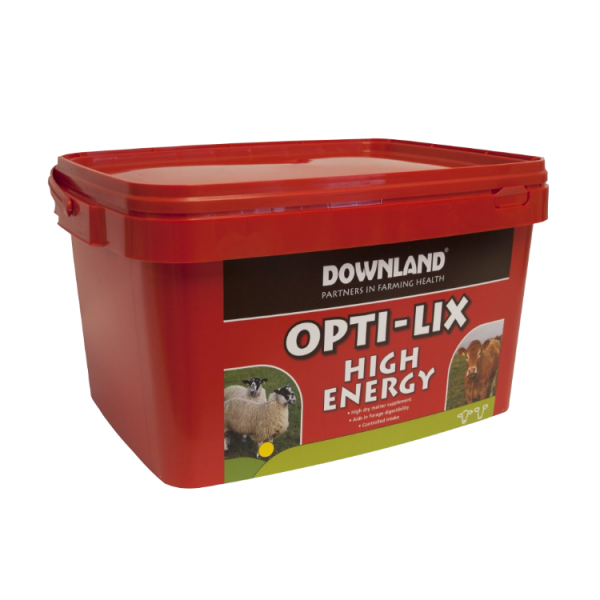5 Steps To Lambing Success
The varied weather and grass growing conditions seen throughout this year have had an impact on forage stocks and quality as we head into this lambing season.
Whilst grass growth has been above average across mid and late summer, quality has been poor, with energy, protein and sugar levels largely below average. This has resulted in forage of variable quality, with silage cuts being low in protein and fermentable carbohydrates and high in indigestible fibre. These more fibrous and less digestible forages may limit intakes in the run-up to lambing and subsequently increase the risk of issues such as twin lamb disease and hypocalcemia if diets are not supplemented appropriately.
1. Prepare Your Ewes
To find out more about preparing your ewes click here:
Up to 70% of foetal growth occurs during the last 6 weeks of pregnancy, the ewe is also preparing to produce colostrum and milk to help the lamb thrive after birth.
Energy to drive growth is most important during this time, but all constituents of the diet are significant. Sufficient high-quality protein is essential for colostrum and milk while minerals, vitamins and trace elements all play a part ensuring lambs get off to the best possible start.
These huge demands on the ewe’s nutrition come at a time when her appetite reduces. Foetal growth means that the lambs take up more space in the abdomen encroaching on the rumen. Ideally nutrient density should increase as lambing approaches, as every mouthful counts.
Understanding your forage is therefore key to success. Forage analysis allows you to identify what supplementation is required to optimise the diet and maximise intakes of crucial nutrients.
2. Feed What They Need
To find out more about feeding what they need click here:
The extensive nutritional demands in late pregnancy will vary significantly depending on how many lambs the ewe is carrying. Getting the balance right will be most cost effective and help prevent common and serious problems. Scanning can help identify singles and multiples so diets can be targeted.
Overfeeding singles will increase the risk of large lambs which can cause problems at lambing. Alternatively underfeeding those carrying multiples increases the risk of metabolic diseases such as twin lamb disease, a ewe carrying triplets requiring up to 10% more energy than a ewe carrying twins.
Twin Lamb Disease (TLD), also known as Pregnancy Toxaemia is commonly seen 3-4 weeks prior to lambing when, demands on the ewe are considerable and in particular inadequate dietary energy forces a ewe to breakdown fat and muscle for energy.
3. Newborn Nutrition
To find out more about newborn nutrition click here:
The first few hours of a lamb’s life are tough. With limited energy reserves and little protection from infection. It’s not surprising that half of lamb losses occur in the first 48 hours after birth. Colostrum is so important for a lamb to survive and get a good start.
Colostrum supplies immunoglobulins to deliver “infection fighting” passive immunity. Newborn lambs have no circulating antibodies or immunoglobulins which are crucial to defend against bacteria and viruses. Good quality colostrum is high in immunoglobulins from the ewe that can be absorbed by the lamb in the first hours of life.
Nutrition from mid-pregnancy onwards is a key driver of colostrum quality and quantity. Colostrum production is affected by liveweight loss in late pregnancy as well as poor body scores. The quality of the protein in the ewe’s diet also makes a difference. Good quality protein providing digestible undegraded protein (DUP) that can bypass the rumen to provide the essential building blocks needed pre-lambing.
4. Assess BCS
To find out more about assessing BCS click here:
Nutrition in late pregnancy is so important, so it’s essential to know the status of the ewe and crucially whether she is losing or gaining weight. Body Condition Score
(BCS) is a useful management tool for farmers.
Target BCS will vary depending on the type of sheep and the farming system but identifying sheep below the ideal BCS early in pregnancy allows time for additional feed or supplementation to prepare them for the demands to come.
Achieving the correct BCS at lambing assists a plentiful supply of high-quality colostrum, reduces losses, improves lamb vigour and bonding and overall has a positive effect on lamb weight at 8 weeks of age.
5. See the Returns
To find out more about seeing the returns click here:
Nutrition on the approach to lambing through to lactation not only impacts this season but lays the ground for the next. While the ewe still has to produce sufficient milk for her lambs, her body must recover and prepare for tupping later in the year. Monitoring BCS plays an important role to ensure diet matches demands. Excessive loss of BSC, or any loss from ewes already below optimum BCS can impact lamb growth and next seasons performance.
Optimising the ewe’s diet throughout pregnancy will also have an impact on the next generation as well. Follicular development in the foetal female lamb is known to be reduced if the ewe is underfed during pregnancy thus impacting fertility and performance for years to come.
Supporting the ewe and lamb on the approach to lambing and beyond.
OPTI-LIX
OPTI-LIX HIGH ENERGY is an extra high energy (16 ME) and protein (12%) feed lick to support energy requirements on the approach to lambing, which also contains a full complement of essential minerals, vitamins and trace elements.
OPTI-LIX HIGH ENERGY has a high sugar content and is ideal for ewes that may be at risk of twin lamb disease
Sheep Natural Energy
SHEEP NATURAL ENERGY is a high energy (13.5 ME) and protein molassed bucket. The 16.5% protein is from all natural sources and includes digestible undegradable protein (DUP) sources to support milk and colostrum production on the approach to lambing.
SHEEP NATURAL ENERGY also contains a full complement of minerals, vitamins and trace elements including protected zinc to support hoof and tissue health.
Opti-Blox
OPTI-BLOX SHEEP ENERGY is a high energy (12 ME) and protein pressed feedblock. High levels of protein including natural and urea sources to support milk production.
OPTI-BLOX SHEEP ENERGY also contains a full complement of minerals, vitamins and trace elements including Availa selenium and zinc which can support colostrum quality, lambing ease and immune system function.
OPTI-BLOX SHEEP ENERGY is ideal for ewes in poorer BCS or those with poorer quality forages.
Understanding ‘the inside story’ on the approach to lambing this season and in particular the importance of optimised nutrition will support a successful lambing season and beyond.
For more information please contact your local McCaskie Sales Rep




